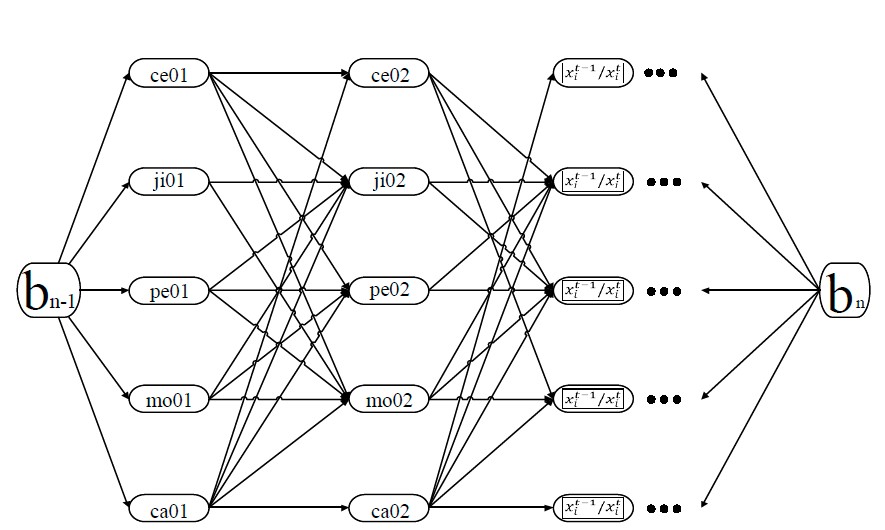Network flow optimization in the formulation of an investment project in Tecamachalco, Puebla
DOI:
https://doi.org/10.29312/remexca.v13i6.2914Keywords:
linear programming, network flow, optimization, projects, vegetablesAbstract
Using linear programming, a network flow model was formulated to optimize the use of the land of small producers in the area of the Tecamachalco Valley, Puebla, Mexico. The optimal crop pattern was estimated in order to increase net profits over a production horizon and obtain financial indicators such as NPV, IRR and B/C R. These values were compared with the traditional methodology of project evaluation. The production horizon was five years for five horticultural crops: onion, tomato, bell pepper, cucumber and zucchini. The results indicated that the optimal crop pattern was to produce tomato in spring-summer (s-s) and bell pepper in autumn-winter (a-w). A NPV of $295 229.84 pesos, an IRR of 68.64% and a B/C ratio of 1.52 were obtained. The net profit of the production plan was $7 422 367.00 pesos, being between 15 and 45% higher with respect to the individual production of each crop. For the selected crops, profits of $6 254 668.49 and $6 339 146.18 pesos were calculated for tomatoes and bell peppers, respectively.
Downloads
References
Alvarado, B. J. 2009. La programación lineal aplicación de las pequeñas y medianas empresas. Reflexiones. 88(1):89-105. https://www.redalyc.org/articulo.oa?id=72912559007.
Bazaraa, M. S.; Jarvis, J. J. and Sherali, H. D. 2010. Linear Programming and Network Flows. 4th (Ed). Editorial Hoboken, New Jersey: John Wiley y Sons, Inc. 748 p. DOI: https://doi.org/10.1002/9780471703778
CONASAMI, 2020. Secretaria del Trabajo y Previsión social. https://www.gob.mx/cms/uploads/ attachment/file/525061/Tabla-de-salarios-m-nmos-vigentes-apartir-del-01-de-enero-de-2020.pdf.
CONEVAL, 2018. Plan Nacional de Desarrollo 2013-2018. Ciudad de México: Consejo Nacional de Evaluación de la Política de Desarrollo Social.
CONUEE, 2011. Estudio de Sistemas de Bombeo Agropecuarios en México, México DF.
CRETEALC-México, 2011. Manejo del acuífero del valle de Tecamachalco, Puebla, México.
Detlefsen, N. K. and Leck, A. L. 2004. Modelling optimal crop sequences using network flows. Tjele, Denmark: University of Aarhus, Faculty of Agricultural Sciences, Department of Agroecology and Environment. 94(2):566-572. DOI: https://doi.org/10.1016/j.agsy.2007.02.002
Forrester, R. J. and Rodríguez, M. S. 2018. An integrer programming approach to crop rotation planning at an organic farm. The UMAP Journal. 38(4):5-25.
Fundar, 2014. Centro de Análisis e Investigación. Infografía: ¿Por qué es importante la pequeña agricultura? Subsidios al Campo en México. https://fundar.org.mx/porque-es-importante-la-pequena-agricultura/.
Gittinger, J. P. 1982. Análisis económico de proyectos agrícolas. Banco Mundial. Madrid, España. 323-442 pp.
Kaiser, H. M. and Messer, K. D. 2011. Mathematical Programming for Agricultural, Environmental, and Resource Economics. United States of America: John Wiley y Sons Inc. 151-155 pp.
Jebelli, J.; Paterson, B. and Abdelwahab, A. 2016. A linear programming model to optimize cropping pattern in small-scale irrigation schemes: an application to Mekabo Scheme in Tigray, Ethiopia. International Journal of Environmental and Agriculture Research. 2(8):24-34.
INEGI, 2018. Encuesta Nacional Agropecuaria 2017, CDMX: https://www.inegi.org.mx/ contenidos/programas/ena/2017/doc/mini-ena17.pdf.
INEGI, 2019. Marco Geoestadístico. Available at: https://www.inegi.org.mx/temas/mg/.
Mohamad, N. H. and Said, F. K. 2011. A mathematical programming approach to crop mix problem. African Journal of Agricultural Research. 6(1):191-197.
Pérez, M. D. 2000. Formulación y evaluación de proyectos de inversión. 1ra. Ed. DICEA. Chapingo, Estado de México: 150 p.
Prisenk, J. and Turk, J. 2015. A multi-goal mathematical approach for the optimization of crop lanning on organic farms: a Slovenian case study. Pakistan Journal of Agricultural Sciences. 52(4):971-979.
Render, B. C.; Stair, R. M. y Hanna, M. E. 2012. Métodos cuantitativos para los negocios. 11va. Ed. México. Pearson Education. 429-457 pp.
Reyes, O. S. y Reyes, R. E. 2018. La historia del crédito agrícola en México. México, DF. Cámara de Diputados LXIII Legislatura. 341-344 pp.
SEDESOL, 2011. Secretaría de Desarrollo Social. Pobreza, migración y capacidades básicas en la población jornalera agrícola en México. Resultados de la Encuesta Nacional de Jornaleros Agrícolas 2009, México, DF.
SIAP, 2019. Sistema de Información Agroalimentaria de Consulta. Ciudad de México: SADER. https://nube.siap.gob.mx/gobmx-publicaciones-siap/pag/2019/Atlas-Agroalimentario-2019.

Published
How to Cite
Issue
Section
License
Copyright (c) 2022 Revista Mexicana de Ciencias Agrícolas

This work is licensed under a Creative Commons Attribution-NonCommercial 4.0 International License.
The authors who publish in Revista Mexicana de Ciencias Agrícolas accept the following conditions:
In accordance with copyright laws, Revista Mexicana de Ciencias Agrícolas recognizes and respects the authors’ moral right and ownership of property rights which will be transferred to the journal for dissemination in open access. Invariably, all the authors have to sign a letter of transfer of property rights and of originality of the article to Instituto Nacional de Investigaciones Forestales, Agrícolas y Pecuarias (INIFAP) [National Institute of Forestry, Agricultural and Livestock Research]. The author(s) must pay a fee for the reception of articles before proceeding to editorial review.
All the texts published by Revista Mexicana de Ciencias Agrícolas —with no exception— are distributed under a Creative Commons License Attribution-NonCommercial 4.0 International (CC BY-NC 4.0), which allows third parties to use the publication as long as the work’s authorship and its first publication in this journal are mentioned.
The author(s) can enter into independent and additional contractual agreements for the nonexclusive distribution of the version of the article published in Revista Mexicana de Ciencias Agrícolas (for example include it into an institutional repository or publish it in a book) as long as it is clearly and explicitly indicated that the work was published for the first time in Revista Mexicana de Ciencias Agrícolas.
For all the above, the authors shall send the Letter-transfer of Property Rights for the first publication duly filled in and signed by the author(s). This form must be sent as a PDF file to: revista_atm@yahoo.com.mx; cienciasagricola@inifap.gob.mx; remexca2017@gmail.
This work is licensed under a Creative Commons Attribution-Noncommercial 4.0 International license.


